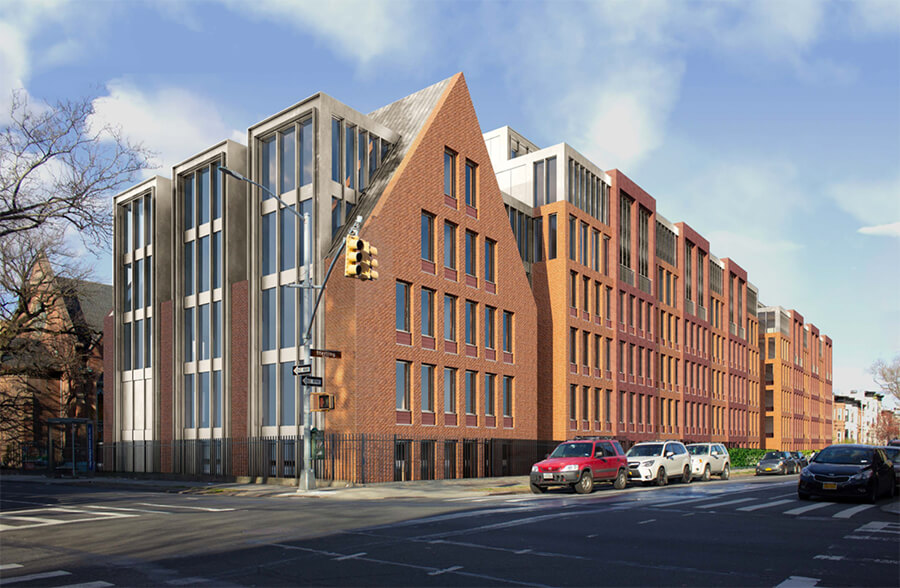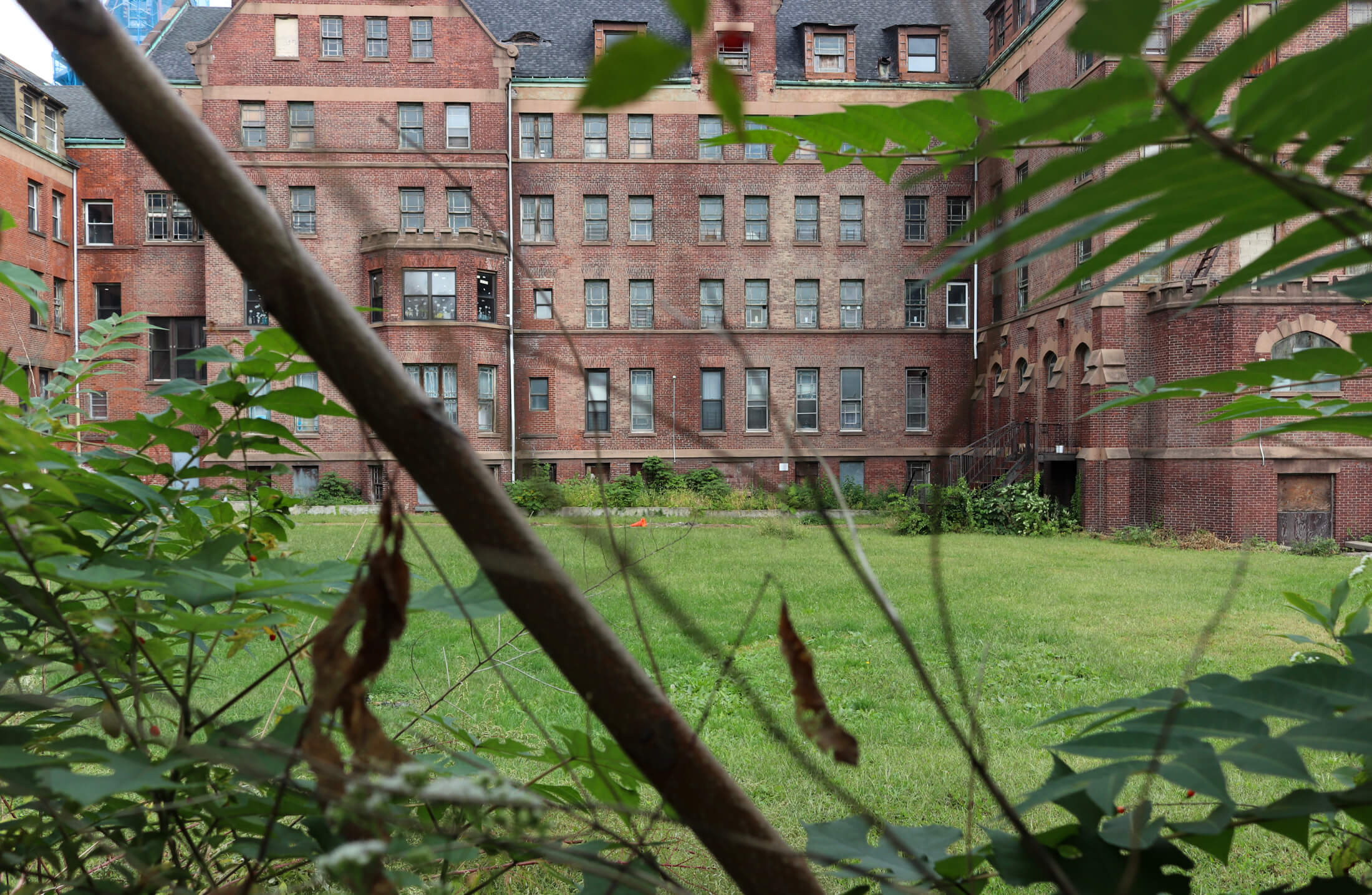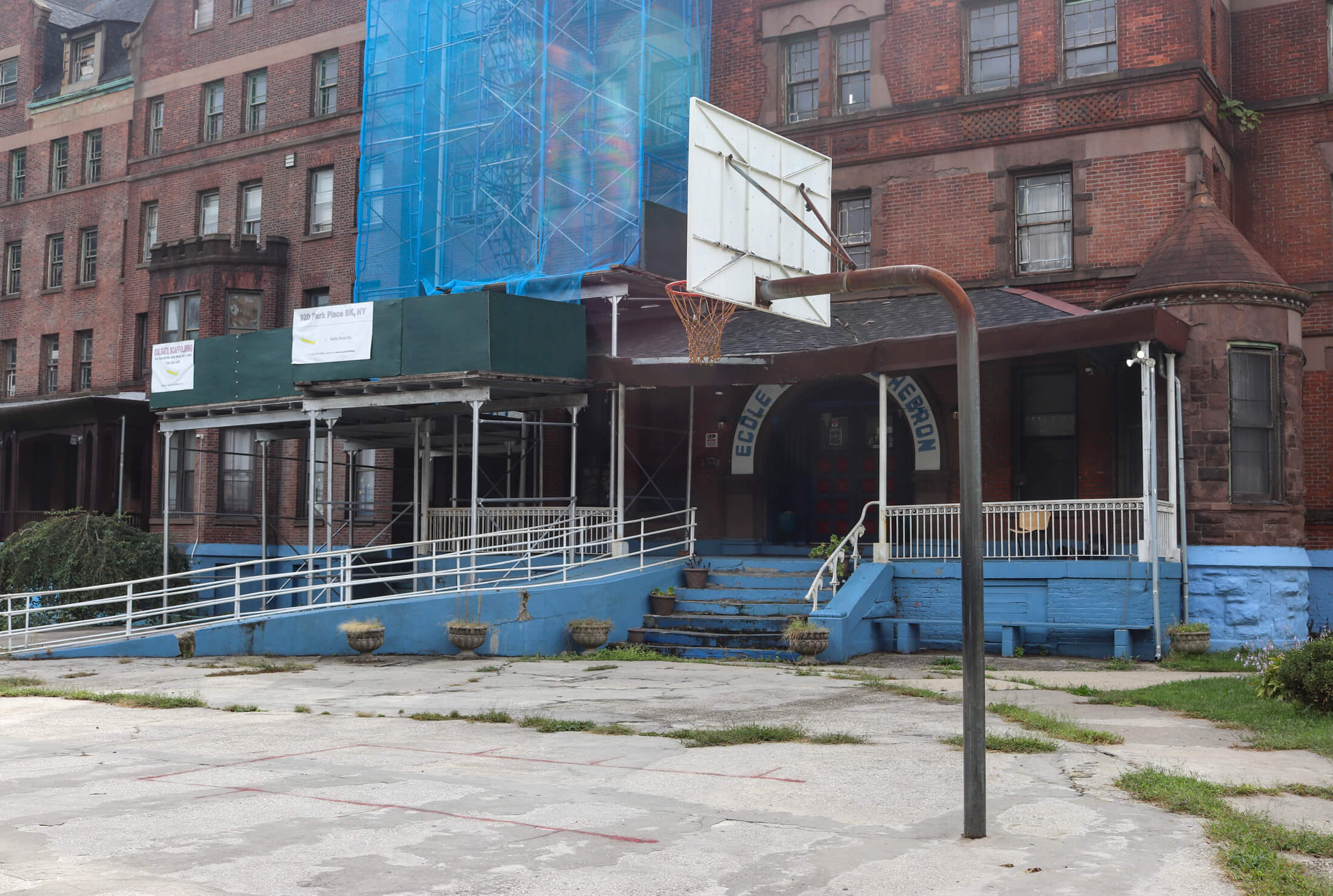Residents Tell Hebron Developer They Want Real Affordable Housing in Crown Heights
At a community board meeting Thursday, roughly 30 people spoke — a combination of concerned residents, congregation members and elected officials.

View from New York Avenue and Sterling Place. Photo by Susan De Vries
During Community Board 8’s Land Use Committee meeting Thursday night, dozens of neighborhood residents turned out online to voice their opposition to the proposed development on the site of the landmarked Hebron School in Crown Heights.
“It’s disgusting,” said local resident Robert Johnson. “I’m disappointed that it would even come this far.”
The project under discussion is a big one: The developer, Hope Street Capital, plans to demolish a mid 20th century addition at the back of the sprawling red-brick Victorian structure and construct a new building that will replace the addition and the open space around it, consuming the entire back end of the block-size property along Sterling Place.

Roughly 30 people spoke at the meeting, a mix of concerned residents, congregation members and elected officials. Others in attendance confirmed that over 150 people were present. Friends of 920 Park and the Crown Heights North Association provided statements, along with President of the Northeastern Conference of the Seventh-day Adventists Dr. Daniel Honore and other church elders. Jeffrey Gershon, head of Hope Street Capital, addressed questions along with his land use lawyer and the project’s main architect, Morris Adjmi.
As Brownstoner reported earlier this week, members of the congregation, who spoke first at the meeting, have come out against the project because many of them see the initial agreement between The Northeast Conference Corporation of Seventh Day Adventists, which owns the property, and Hope Street Capital, to be one that did not include members of the church.
Ritha Pierre, a congregation member, said that the vote Northeast Conference claims occurred was misunderstood by many in the congregation. “Knowing the population of the church, a majority of them did not understand what was going on” because of a language barrier, she said. Pierre added that many young people in the congregation expressed objections at the time but were ignored, and the ultimate vote was just a show of hands, with nothing official on the record. “It’s always been shady, in my opinion,” she added.

The majority of residents who spoke said they were concerned about the project’s planned affordable housing — or, rather, what they view as housing that will not be affordable. “This is not a neighborhood where the median income is 130 percent above the Area Median Income. We’re a very low-income neighborhood,” said Robb Mandelbaum, who lives on Sterling Place. He suggested that Hope Street Capital should choose the option in the Affordable New York program that dictates that 10 percent of the affordable units be at no more than 40 percent of the Area Median Income, 10 percent at no more than 60 percent and 5 percent at no more than 130 percent.
When pressed, the developer refused to say which option of the Affordable New York program they would choose. (Under the program, 30 percent of the apartments in the complex could be set at 130 percent of Area Median Income, with no other affordable units. In practice, such rents are often little different from market rate.)
Councilmember Robert E. Cornegy Jr. also spoke at the meeting but, much to the chagrin of others present, said he needed more time to think about the project and talk to people at the church. “I don’t think development should hurt people,” he was quick to add, before saying he was unprepared to make a statement at this time. In the chat room that accompanied the digital meeting, members of his staff argued with residents, who had begun sending messages of support to his opponents in the 2021 race for Brooklyn Borough President. (Cornegy acknowledged participants in the chat room were unhappy at the end of his comments.)

The presentation team, which included the architect Morris Adjmi as well as preservation consultants, argued that the proposed new building was influenced by the historic architecture that surrounds it, and that LPC has previously approved projects much like this one. Dr. Honore, along with two other pastors from the church, argued that they saw no alternative to make needed repairs to the school. “We know no other way,” Honore said.
But residents, who unanimously opposed the project, thought that the new building “competes, rather than be deferential to” the historic structure, as Brownstoner columnist and Crown Heights North Association member Suzanne Spellen said in a statement for the organization. (The only people who spoke in favor of the project at the meeting were members of the development team and church leaders.) Other residents asked how the amount of glass and steel that is visible in the renderings could make the new buildings coexist with the historic neighborhood. The school building and its grounds are landmarked as part of the Crown Heights North Historic District II.
Despite members of the Hope Street Capital team saying they wanted the subcommittee to vote and make their recommendation that night, the land use committee said they would like to see materials regarding the affordable housing component of the project first.
After the committee makes its recommendation, the project will next go in front of the full community board. Then its fate will be in the hands of the Landmarks Preservation Commission. By law — recently reaffirmed in another Crown Heights case — the commission will not consider affordable housing or use but only the effect of the proposed structure on the historic character of the landmarked school building and the landmark district.
In recent years, as property values have skyrocketed, many Brooklyn churches in need of funds (as well as other enterprises — even public libraries) have struck deals with developers to build on their properties, with a range of results. Few have been in landmark districts.
But overall, the community members who voiced their opinion so far said they feel like the project remains alien to their neighborhood. “We have loved this community, we have grown in this community, we have neighbors who have been here 10, 20, 30, 40 years,” said Gerianne Scott, whose parents, she told the community board, purchased a house across the street from the site 70 years ago. “It’s because of the beauty, and the air, and the sea, and the sky and the neighborhood. You cannot do this!”
[Photos by Craig Hubert unless otherwise noted]
Update: The land use committee voted 14-2 against the project Thursday. An LPC hearing has been scheduled for Tuesday, October 20.
Related Stories
- Congregation Members Join Advocates Against Development at Hebron School in Crown Heights
- Despite Building Boom, Housing in Brooklyn Is Not Getting More Affordable
- Crown Heights Church Proposes Controversial Mixed-Income Housing in Landmark District
Sign up for amNY’s COVID-19 newsletter to stay up to date on the latest coronavirus news throughout New York City. Email tips@brownstoner.com with further comments, questions or tips. Follow Brownstoner on Twitter and Instagram, and like us on Facebook.









What's Your Take? Leave a Comment